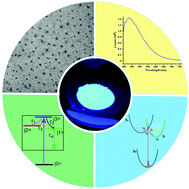Visualizing ultrasmall silica–CTAB hybrid nanoparticles for generating high photoluminescence†
Abstract
Generating photoluminescent (PL) materials with high quantum yields and excellent stability has been a long-standing goal in the fields of materials and chemistry. However, it remains a challenging task to synthesize ultrasmall PL particles and visualize the underlying physical mechanism of synthesis. Here, we have reported the synthesis of spherical silica–CTAB hybrid nanoparticles (SCHNs) with a mean diameter of around 12 nm, which can exhibit a high PL quantum yield of up to 41.8% and long PL lifetime of up to ten microseconds under 365 nm excitation. We examined the stability of SCHNs, which did not diminish after exposure to an ambient environment for longer than 12 months and did not bleach after 365 nm UV irradiation for longer than 48 hours. The emission maximum of such SCHNs was greatly enhanced as compared with that for CTAB. We propose a collective-state model via dipole–dipole interactions to gain insights into these exciting phenomena. By identifying four critical intramolecular processes within the model, we reproduced the PL decay traces of SCHNs upon 365 nm excitation with high quality. This work provides a new type of inorganic–organic hybrid PL nanoparticle by using the commonly used CTAB as the primary raw material.



 Please wait while we load your content...
Please wait while we load your content...